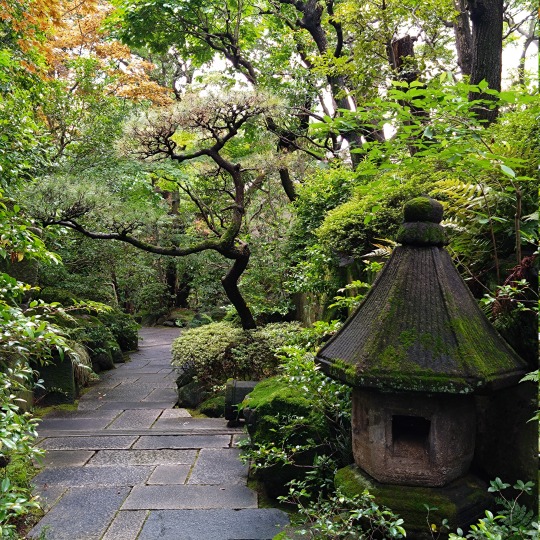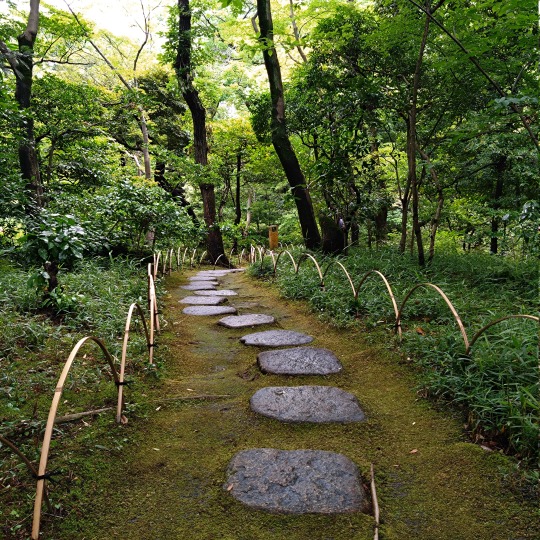#nezu museum
Text

NEZU Museum, Tokyo
#nezu museum#japan aesthetic#japan#japan travel#mine#tokyo#dark aesthetic#minimalism#garden#japanese garden
5 notes
·
View notes
Text
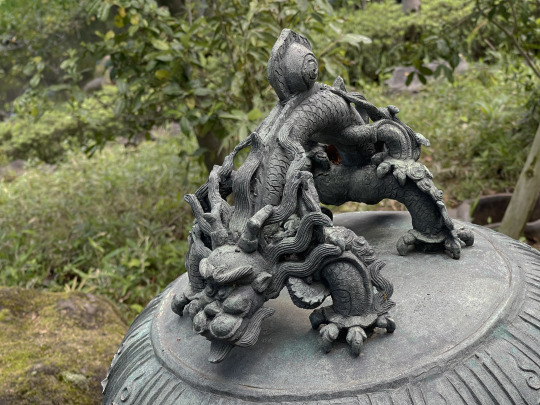
Bell Crown in the Nezu Art Museum's Garden.
5 notes
·
View notes
Text
2 notes
·
View notes
Text
Weekend treat: for an annual event at Nezu Museum in spring!
28/4/2023
An instructor of a course in Japanese Art talked about an annual event at Nezu Museum in spring, and it is "Irises(screen)" by Korin Ogata exhibition. Then, I was being so curious about it that I was off to this art gallery in Minami-Aoyama all the way after school.

This is known for its entrance as beautiful architecture designed by Kengo Kuma and in a lot of magazines, I remembered. Therefore, I was delighted to see it. Yet, the place appeared to be too exclusive for me, and I found elderly people being formal in their attire but living within a kilometer suitable for it. I was being a little out of place.

Having said that, I immersed myself in the exhibits/collections of the gallery, knew of Otsu-e, a folk art in 17th century in Shiga, and had fun strolling the Buddhism themed garden. I want to take my parents there one day.

#nezu museum#minami-aoyama#short trips#weekend treat#japanese art#irises#korin ogata#spring#yamato-e#buddhism#garden#tokyo#kengo kuma
0 notes
Text
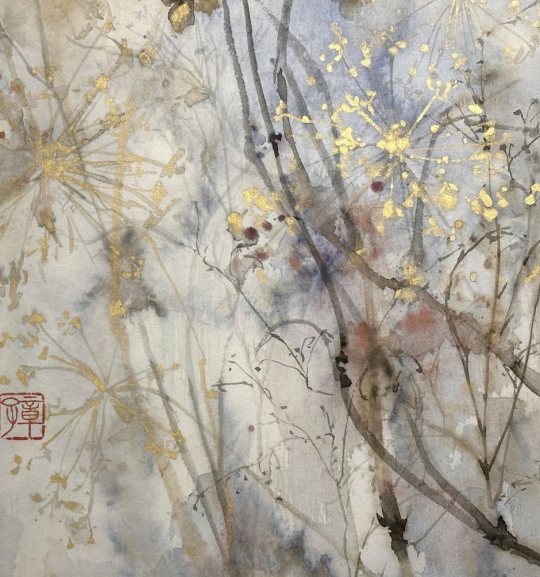

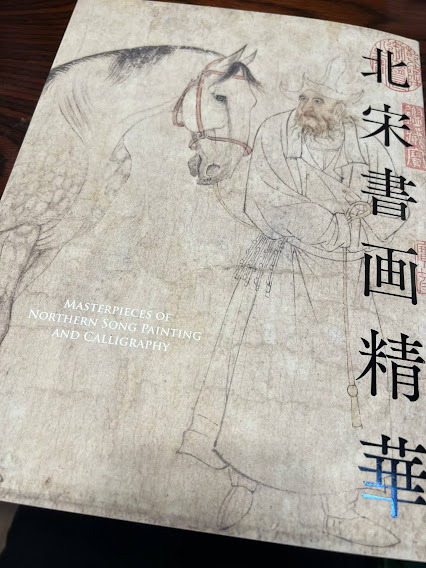
2 pieces of art works by 新倉 章子 Niikura Akiko /Japanese @Ochikobolenomi 墨の花
企画画廊くじらのほね
新倉章子展 開催中
8時まで在廊しています
I love this artist. and her art shows openning today. If you're interested her art works (ink of flowers), please go to see her art shows supporting her.
and she went to see this art shows at 根津美術館 - about Legendary Exhibition on Northern Song Chinese Painting and Calligraphy: Highlights at the Exhibition, “Masterpieces of Northern Song Painting and Calligraphy”, I am so happy for her. and she said that :
五馬図見て参りました。
予約必要ですがわりと混んでいました。
北宋山水も何点もみることができました。
李唐山水図には格別なものを感じます。
日本東京根津美術館《北宋書畫精華特展》Masterpieces of Northern Song Painting and Calligraphy
2023年11月3日~12月3日
3 November-3 December
Nezu Museum, Tokyo Japan
此次展覽包括中國北宋時期代表畫家李公麟兩件傳世名跡《五馬圖卷》《孝經圖卷》,北宋人物畫名跡《睢陽五老圖》冊頁中的《畢世長像》等多件珍貴名作以及日本寺院珍罕宋代佛畫等。
宋代是中國書畫史上的巔峰,從日本中世紀(1185-1573年)開始,在日本的中國藝術鑑賞家就開始珍藏南宋(1127-1279年)的作品。此外,平安時代晚期(11世紀和12世紀),北宋時期(960-1127年)的作品也幾乎同時被帶到日本。到了近代隨著清朝結束和中國藝術品的外流,日本的企業家們開始積極收集中國藝術品,認為它們至少應當留在亞洲;因著他們的收藏使更多北宋書畫精品流傳到日本。
Thanks! Lan~*
#新倉章子#niikura akiko#@ochikobolenomi#japanese#日本東京根津美術館《北宋書畫精華特展》#masterpieces of northern song painting and calligraphy#nezu museum-tokyo japan
14 notes
·
View notes
Note
Hi there! Hope you’re well and not melting away in the humidity. I am super excited to be planning a trip to Japan again after almost four years away. Considering I lived 1) in Kansai-ish territory and 2) near Nagoya, I never got much chance to explore Tokyo outside of the usual tourist places. I already have Jinbocho on my list (along with one of the Aoyama flower market tea houses and Nakano Broadway)— do you have any suggestions for what’s fun in Tokyo for someone who is a little more experienced with the area?
Welcome back!
Now here's a challenge! I don’t know whether you're looking for new & trendy, or old & traditional, and a lot depends on the season, but…
1) Stroll from Ueno Park or Nezu to Yanaka and Sendagi. See if you can find Snake Street and follow its curves. Yanaka is as Kyoto as Tokyo gets. Yanaka and Kagurazaka.
2) Shibamata for more old Edo vibes. Cross the river on the ferry. Only ferry in Tokyo.
3) Sunamachi Ginza Shopping District in Koto-ku: another old area that's being transformed by gentrification.
4) Get lost in Shibuya Station, just for fun, but take tranquilizers with you. Walk from Shibuya via Shoto to Yoyogi Park. Shoto is one of the wealthiest areas in Tokyo, but it's not as famous as, say, Azabu-Juban or Denenchofu. Stop at Levain for bread and Fuglen for coffee.
5) Explore the swanky, hipsterish areas of Kichijōji, Shimokitazawa, Daikanyama. Take the Setagaya Tram Line from Sangenjaya to Gotokuji and visit the temple birthplace of the famous maneki-neko. Lots of tiny shops and quaint shopping streets in a relatively upmarket area along the way.
6) Okutama. Walk along the Mitake Valley Riverside Trail, from Ikusabata to Sawai, stop for sake at the Sawanoi Sake Brewery, visit the Gyokudo Museum. You can continue past Mitake to the Okutama Fishing Centre. If you are here in autumn, you'll see breathtaking autumn colours.
7) Yokohama! Not exactly Tokyo, but a nice day trip. Minato-Mirai, Yokohama Foreign General Cemetery (no, seriously, Google it), Sankeien Gardens.
I'm not a food expert, but there are really nice restaurants in all these areas. Add Yakitori Alley in Yurakucho to your list: great atmosphere. (There's a maze under the tracks between Yurakucho and Shimbashi. Well worth a visit, but it gets a bit dystopian.) Museums? Fukagawa Edo Museum in Kiyosumi, all the art museums in Ueno Park. Plants 'n stuff? Yumenoshima Tropical Greenhouse Dome. Shinjuku Gyoen remains my favourite Tokyo park/garden.
It's very touristy, but so iconic that it's really worth it: New York Bar and Grill in the Park Hyatt Tokyo. Expensive though. Cocktail Works is a craft gin bar in Kanda (close to Jimbocho), and a very good alternative (but without the glorious view) (which is the whole point) (actually).
Oh, by the way, Piss Alley in Shinjuku? So yesterday. Try Sankaku Chitai in Sangenjaya or Nogecho in Yokohama instead. Shh, don't tell anyone.
Best free and still relatively uncrowded view of skyline: Bunkyo Civic Center observation lounge. Shh again.
Would this suffice? If you send more details about your timing and what you're interested in, I'll happily add more.
Enjoy the planning as much as the trip! 😊
65 notes
·
View notes
Note
thank you for the reply and the information! I was curious how the other fox would fit in with PCB Extra's metatextual mention of Three Lands, but I hadn't even considered it might be three worlds and not three countries. this is neat
(Original post for context)
I forgot I left the response to this in my drafts, sorry. Luckily, this means I could update it with recently acquired knowledge when I found it again.
Truth to be told, my point is less that the other fox is a better match, and more that Ran being Tamamo no Mae is one of these things which make sense at first glance, but the deeper you look into it, the less coherent it becomes.
This got much longer than I planned, so for organizational purposes let's refer to this post as Revenge of the "graveyard god", or why I don't think Ran is Tamamo no Mae. More under the cut.
The early Tamamo no Mae
The main point of connection between Tamamo no Mae and Ran are the nine tails, but that’s not even really a consistent part of the former's background. The oldest version of the story - which is really fun, the seduction section is pages upon pages of Tamamo and emperor Toba discussing esoteric Buddhism - states that she was “an 800-year-old two-tailed fox from the Nasuno Plain in Shimotsuke Province”. Early depictions of her true form follow this pretty closely:

Nezu Museum of Art, via Monsters, Animals, and Other Worlds. A Collection of Short Medieval Japanese Tales
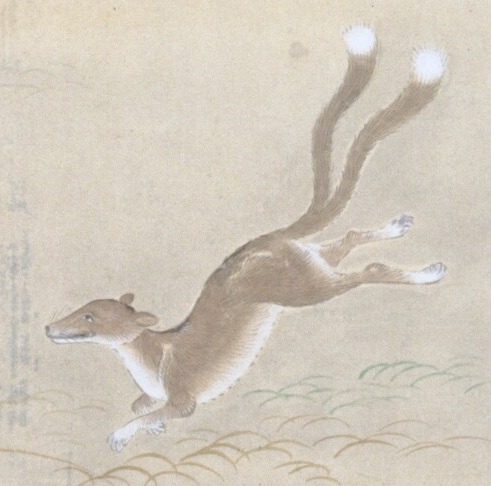
Kyoto University Rare Materials Digital Library

Suntory Museum of Art
As far as I am aware, the two tails are actually unique to her. Other foxes of note have either one tail or nine. While it does seem the belief in the number of tails growing with age is genuine rather than a modern misconception, it’s hardly central to fox folklore (I’ve seen the portmoneu “foxlore” at least once btw, it’s very funny). And, as I will outline later, it doesn’t even seem to be behind the idea of nine-tailed foxes in the first place.
Anyway, the oldest version does provide Tamamo with more backstory, but it’s closer to presenting Shuten Dōji as a manifestation of Mara than to a straightforward “Tamamo is x under a pseudonym” popular today. As we learn, the two-tailed fox is in fact a reincarnation of a “graveyard god” (塚の神, Tsuka no Kami) from India, described in the apocryphal Humane Kings Sutra (it gets namedropped directly), likely originally composed in China.
How come? It all started when Kalmashapada, a prince of Devala in India, wanted to offer 1000 skulls of virtuous rulers to this deity because a suspicious “heretical” preacher convinced him it’s a good idea. After defeating and imprisoning 999 such kings, he encountered Shrutasoma, one of the previous incarnations of the historical Buddha, who managed to show him the error of his ways. All of the kings were released, and Kalmashapada was redeemed.
The “graveyard god” was less than thrilled, and swore to keep reincarnating as a fox in kingdoms where Buddhism flourished to destroy it. We are told that happened many times, but only one past identity, that of Bao Si (Hōji), comes up. Obviously, eighth century BCE China was not exactly an area famous for Buddhist devotion, but that’s irrelevant here. We are told the endgame is not just to overthrow a righteous ruler, but also to become his replacement. Alas, Tamamo no Mae obviously fails at both of these goals. Still, points for trying.
The story does not provide the deity with a specific identity. However, Nobumi Iyanaga notes that in the referenced sutra he’s Mahakala (the original Makakaraten version, not the joyful Daikokuten). In East Asian Buddhism he is described as dwelling in the graveyards due to acting as both the chief of dakinis and their subduer. At the same time, Iyanaga argues in the context of the Tamamo no Mae story it can be argued he is either implicitly replaced by the dakini par excellence, Dakiniten (closely associated with foxes), or that the deity has no identity other than the fox one.
Later Tamamo developments
Two elements which are mainstays of modern retellings are missing from the oldest version, as you might have noticed. It doesn’t feature the Sesshōseki, which was only added later, seemingly as a way to promote Zen Buddhism, since this extension of the story casts a member of this school as the new protagonist. In the early variants Tamamo’s corpse was brought to the imperial treasury, the same one which shows up in a similar context in the tale of Shuten Dōji, and there is no indication she came back as a vengeful ghost, let alone that she repented and accepted Buddhism, as she does in some of the Sesshōseki variants.
The other difference is, as I already pointed out, the tails. The oldest depiction of a nine-tailed Tamamo no Mae I am aware of is Sekien’s. Based on a few papers I read it would appear textual variants of the story giving her nine tails might have been in circulation earlier, but that’s not reflected in any of the illustrated scrolls shown above.

Sekien's nine-tailed Tamamo (wikimedia commons)
Sekien claims that Tamamo no Mae is one and the same as Daji (I’ll get back to her later), and specifies the latter was a nine-tailed fox. He cites Zhang Dingsi’s Langye Dai Zui Bian (浪挪代醉編, “Langye’s Substitute for Drunkenness: A Compilation”) as his source for this tidbit, but does not explain where does the conflation of the two foxes come from. In contrast with the elaborate reincarnation scheme from the older version, he states Daji simply flew across the sea to reach Japan, without reincarnating.
What is now essentially treated as the “definitive” version of the Tamamo no Mae story, and what cemented her image as a nine-tailed fox, only dates back to 1805. That’s when Ehon Sangoku Yōfuden (絵本三国妖婦伝; “Tales of Enchantresses in the Three Kingdoms”) finished publication. The author, Ranzan Takai (高井蘭山), was an enthusiast of neo-confucian thought, and he wanted to write a story highlighting the time honored confucian belief that dynasties are brought down by suspicious concubines. The real goal was somewhat broader, though -the story of Tamamo no Mae was essentially repurposed as a critique of the concept of women playing an important role in public life.
It needs to be noted here that it is not impossible that the original was already part of a political polemic. Arguments have been made that Tamamo is a fictional representation of Bifukomon-in, for instance. They are certainly linked to the same emperor, Toba.

Bifukomon-in (wikimedia commons)
However, while I would not rule this out altogether, it’s hard to deny the typical medieval penchant for reinterpreting Buddhist material feels more central to the story. It is ultimately a very elaborate twist on the Humane Kings Sutra first and foremost. It belongs to the same world as other fabulous tales about figures from distant Buddhist lands arriving in Japan, alongside the likes of the legend of emperor Suwa of Hadai or the medieval Amaterasu narrative involving Mara (stay tuned for my post about that one).
Ideological motivations aside, in Ranzan’s version an anonymous nine-tailed fox appears as Daji in China, Kayō in India (seemingly a leftover of the original “graveyard god” story; here the prince is convinced to carry out his evil plans by his concubine instead though), and finally Tamamo no Mae in Japan. He also gives a unique account of Tamamo’s arrival in Japan, as far as I am aware: in his novel, she was brought there by Kibi no Makibi, a famous historical envoy to China. This was not his first time as a literary character, a much earlier picture scroll about his adventures is pretty funny (I have Touhou ocs based on it), but I’ll save this discussion for another time.
Not quite Tamamo: the influence of Daji
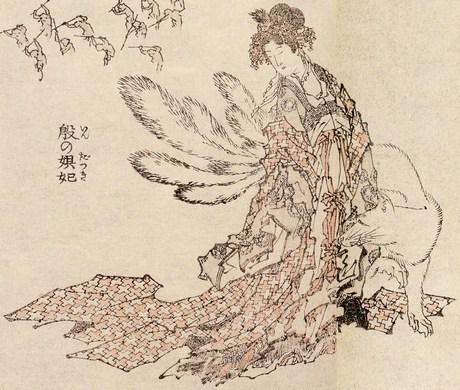
Daji, as depicted by Hokusai (wikimedia commons)
Daji requires some further discussion. She was initially regarded simply as a non-supernatural wicked concubine, but came to be treated as a fox posing as a human by the Song period. According to Xiaofei Kang the oldest evidence for that comes from 1101, from a Japanese text presumably reflecting an already extant Chinese belief. By the Yuan period it became a commonly accepted view, with Quanxiang Pinghua (全相平話) specifically stating Daji had nine tails. Her fox-like image was finally cemented fully by popular novels in the Ming and Qing periods.
Since there was a preexisting tradition in which Daji was a human woman, a remedy was developed: the “real” Daji was possessed by a fox, who took her name and identity. Curiously, the fox component of her story is otherwise not very important, and some modern authors basically characterize it as “tacked on”: she is the quintessential evil concubine bringing kingdoms to ruin out of a sense of cruelty who just happens to be a fox, and her story doesn’t really depend on preexisting fox-related motifs.
There are multiple accounts of Daji’s deeds, but the most famous one, and at the same time the most likely influence on Razan’s portrayal of her (and thus Tamamo), is Investiture of the Gods. However, he skips the origin attributed to her here: in the Chinese original, Daji is an agent of the goddess Nuwa, though she eventually overdoes it and is rebuked by her former boss for excessive cruelty. This doesn’t really fit well with Tamamo’s backstory, obviously; making her and Daji interchangeable was detrimental to both characters, I feel.
A Chinese story dealing with Daji reincarnating does exist, but it’s not exactly similar. In the Ming novel Zhaoyang Qushi (昭陽趣事) she reincarnated as Zhao Hede, a concubine of emperor Cheng of Han. What happens next has been described as “pornographic entertainment enlivened by supernatural and historical costumes”. For more details, check out Rania Huntington’s book from the bibliography below.
Curiously, it is possible Daji was simultaneously an object of active cult, since there is a Song imperial edict outlawing the shrines dedicated to her, Wutong (a southern Chinese spirit who was believed to bring wealth and bewitch people, compared with foxes in the north) and “General Shi” (no clue who that might be, I’d hazard a guess one of the popular pacified vengeful spirit cults but don’t quote me on that). However, another contemporary source instead mentions the outlawing of temples of “fox kings”, so it might also mean that the name of Daji was applied by officials to an unrelated popular fox cult (“fox king” is a reasonably common appellation for supernatural foxes). Both regular and nine-tailed foxes are attested in such a context across history.
Early nine-tailed foxes

An early Chinese depiction of a nine-tailed fox (wikimedia commons)
The early portrayals of nine-tailed foxes are something I started looking into recently because of Ran’s freshly revealed connection to Yuuma: I figured it makes sense that she’d be in origin someone who belongs to the same world as the taotie.
Looking at the earliest Chinese sources, multiple nine-tailed foxes appear in legends about virtuous rulers like Tang, Wen or Yu the Great, essentially as generic good omens, without much fanfare. According to confucian commentaries from the Later Han period, the nine tails were understood as a sign a given emperor will have many descendants. The exception from this generally positive tendency is the Classic of Mountains and Seas, where the nine-tailed fox is described as “man-eating” (something very uncommon in Chinese fox literature). However, it also doesn’t exactly get more spotlight than the other creatures. It’s also treated as a separate animal from regular foxes, not as a particularly old fox. You could say it is to the fox what a bai ze is to an ox, I think.
Visual arts add further specimens: the source of this discussion, the nine-tailed fox attendant of Xi Wangmu, later seemingly “decanonized”, and another belonging to the entourage of Zhong Kui. Both of these are hardly eminent and seem to fit the mold of auspicious omens. In Zhong Kui’s case the fox is in one case listed alongside the bai ze which only strengthens this impression. However, it also makes sense that its inclusion would reflect Zhong Kui’s role as a demon queller: he is often portrayed with conquered demons as servants, after all.
Conclusions

To sum up: ultimately it just doesn’t seem nine-tailed foxes are quite as big of a deal as popculture makes them seem, and nine tails are neither exclusive nor innate to Tamamo no Mae. Since that’s the only real point of connection between her and Ran save for a throwaway PCB line which leads to no further references, I maintain there’s no strong case for identifying them with each other, especially since there is no shortage of other candidates.
There’s also the fact that, Daji aside, most other nine-tailed foxes are largely blank slates you can do anything with, while Tamamo has many fairly unique characteristics which would be wasted by randomly slapping her name on Ran, in my opinion. To be fair, ZUN does occasionally make similar mistakes - Yoshika is the main example (remember, the actual legend about Yoshika’s immortality claims he decided to pursue eternal life after having a thrilling affair and has him call himself “strongest madman under heaven”).
I would personally argue ZUN himself probably did not feel strongly about who Ran is supposed to actually be when he originally came up with her, though. None of her spellcards reference Tamamo no Mae. Or any other fox identified with her, for that matter. They do have a more or less consistent theme, but that theme is, broadly speaking, “magic arts”, from onmyodo (Shikigami "Banquet of the Twelve General Gods"), through shugendo (Illusion God "Descent of Izuna-Gongen", Shikigami "The Protection of Zenki and Goki", Superhuman "Soaring En no Ozunu") and esoteric Buddhism (Shikigami "Channeling Dakiniten", Esoteric Sign "Odaishi-sama's Secret Key"), to contemporary stage magic (Shiki Brilliance "Princess Tenko -Illusion-"). In other words, I do not think canon actually strongly supports any specific option.
I will admit I’m biased but personally I think picking a different fox makes it much easier to accommodate Yuuma and their shared animal realm past, the most thrilling Ran development in ages. As for Tamamo, I do think she would be fun to see in Touhou, but preferably as her own character - with two tails, if possible.
Bibliography
Bernard Faure, The Power of Denial. Buddhism, Purity, and Gender
Rania Huntington, Alien Kind. Foxes and Late Imperial Chinese Narrative
Nobumi Iyanaga, Under the Shadow of the Great Śiva: Tantric Buddhism and its Influence on Japanese Mediaeval Culture
Idem, Dākinī in: Brill's Encyclopedia of Buddhism (vol. 2)
Xiaofei Kang, The Cult of the Fox: Power, Gender, and Popular Religion in Late Imperial and Modern China
Laura K. Nüffer, Lady Tamamo in: Keller Kimbrough and Haruo Shirane (eds.), Monsters, Animals, and Other Worlds. A Collection of Short Medieval Japanese Tales
Sumiko Sekiguchi, Gender in the Meiji Renovation: Confucian 'Lessons for Women' and the Making of Modern Japan
Chun-Yi Joyce Tsai, Imagining the Supernatural Grotesque: Paintings of Zhong Kui and Demons in the Late Southern Song (1127-1279) and Yuan (1271-1368) Dynasties
34 notes
·
View notes
Photo

Nezu Museum, Tokyo
via instagram @jinwanchilam
202 notes
·
View notes
Text
Random Research O'Clock for a one-off snippet about Sir Nighteye, who according to the Ultra Analysis book was born in Tokyo... among other characters including the rat, led me to a funny possibility as to Nedzu's name origin.
As a quick reminder this is how Nedzu's name is written: 根 (ね) 津 (づ) which as we know is a play on ねずみ (nezumi, or rat).
From the Wikipedia page for the thing I stumbled across while doing research on what school Sasaki could've attended in Tokyo assuming he didn't go to UA:
The Nezu Museum (根津美術館, Nezu bijutsukan), formerly known as the Nezu Institute of Fine Arts, is an art museum in the Minato district of Tokyo, Japan. The museum houses the private collection of pre-modern Japanese and East Asian art of Nezu Kaichirō (1860–1940). The museum foundation was established on the death of the founder Nezu in 1940 and exhibitions were first opened to the public in 1941.
An art museum whose origins sounds not unlike the Barnes Foundation.
I'm gonna have fun with this idea.
#random thoughts#my hero academia#boku no hero academia#nedzu#nezu#principal nezu#principal nedzu#bnha nezu#bnha nedzu#mirai sasaki#sir nighteye
17 notes
·
View notes
Note
MSRA: I love the “Break out the museum piece” trope. So Nezu bless that Gran Torino ask.
Also had the idea that mechs took a while to actually come about, so now I’m thinking that 4th OfA went into woods, and came out to watch some big ass robots fight and really considered going back.
Gran Torino is the museum piece
4th completely missing a generation of technology to bridge the gap between weaponry and mechs is hilarious
26 notes
·
View notes
Text
The Art of Japanese Tea Ceremonies in Tokyo Kyoto and Osaka
🍵✨ Calling all tea enthusiasts! Ready to journey through the world of Japanese tea ceremonies? Let's sip our way through Tokyo, Kyoto, and Osaka! From the bustling streets of Tokyo to the serene temples of Kyoto, get ready for a tea-rrific adventure!
🌸 Ever tried to decipher the secrets of a Japanese Tea Ceremony? It's like a graceful dance, where every move and sip tells a story! Get ready to immerse yourself in Chanoyu, Matcha Madness, and even some Geisha tea magic!
🍵 Curious about what really happens during a Japanese Tea Ceremony? Picture this: serene gardens, delicate teacups, and the soothing sound of bamboo whisks. It's a brew-tiful symphony for the senses!
🏙️ Tokyo: Where Tradition Gets a Modern Twist
Get your tea fix in Tokyo, where ancient customs meet futuristic flair! We've got hidden gems like Chazen and Nezu Museum waiting to whisk you away on a tea-scapade!
🌸 Kyoto: Where Tradition Blooms Like a Cherry Blossom
Step into Kyoto, the heart of traditional Japan, and prepare to be enchanted by Geisha tea ceremonies! Don't miss spots like Camellia Tea Ceremony and Maikoya Kyoto for a taste of tea-time elegance!
🏯 Osaka: Where Tea Takes Center Stage
In Osaka, tea culture is a blend of tradition and innovation! Swing by Maikoya Osaka and Tea Ceremony Osaka - The Osaka for a sip of tea and some belly laughs!
☕ English Tea Ceremonies: Lost in Translation? Not Here!
Can't speak Japanese? No problem! Many tea ceremony spots offer English sessions, so you can "chai" your hand at this ancient art!
Ready to steep yourself in Japanese tea culture? Join us on this tea-riffic adventure! Check out the complete blog post for a brew-tiful guide. ☕🌸✨
4 notes
·
View notes
Photo

A copy of the Kumano Mandara (熊野曼荼羅) dating to the 14th century, a mandala depicting the universal Buddhist divinities thought to manifest as local deities in the Kumano area, with Amida Buddha (阿弥陀如来) as the source of the main deity of Kumano Hongū Taisha Shrine (熊野本宮大社) in the center
Color on silk, from the collection of the Nezu Art Museum (根津美術館) in Tokyo
#japanese art#buddhist art#曼荼羅#mandala#熊野曼荼羅#kumano mandara#熊野三山#kumano sanzan#阿弥陀如来#阿弥陀#amida nyorai#amida
22 notes
·
View notes
Photo

Nezu Museum, Shibuya, Tokyo, November 2022
17 notes
·
View notes
Note
Thirteen. I love you. I love, love, love, love, love, love, love, love, love, love, love, love, love, love, love, love, love, love, love, love, love, love, love, love, love, love, love, love, love, love, love, love, love, love, love, love, love, love, love, love, love, love, love, love, love, love, love, love, love you. You are the best friend I want. The person I want to take out to a nice tea shop. I wanna go to museums with you. I wanna rub lotion on your back. I wanna give you shoulder massages. I want to go on a nature walk with you. You have beautiful hair. Wonderful and mysterious eyes. A very loving and slow-to-anger personality. I find your interests, interesting. I love your motivation to do right and I love that you stand by it. I love your cheerful personality and lovely bubbly smile. You bring joy and wonder to a room. I love it when you nerd out, it's so cute to watch. You are so good and loving to Eri, the other teachers and the other students. I KNOW FOR A FACT that Nezu and everyone appreciates you. These anons haven't bothered getting to know you and are sadistic. 🪐⭐✨🌙💫🖤🤍🖤🤍🖤💙💜

this is going to be one of those messages she keeps pinned to her wall to look at every time she has a bad day
49 notes
·
View notes
